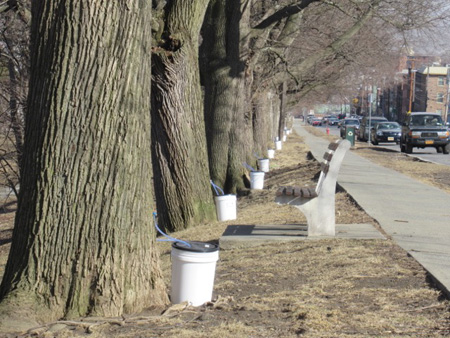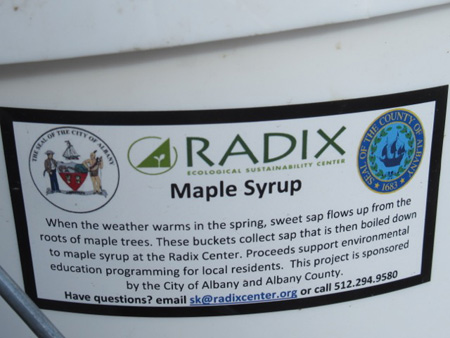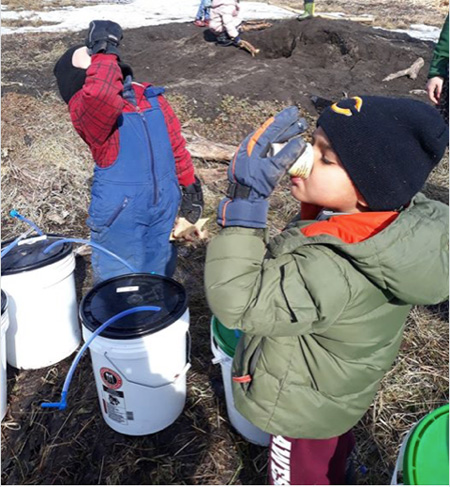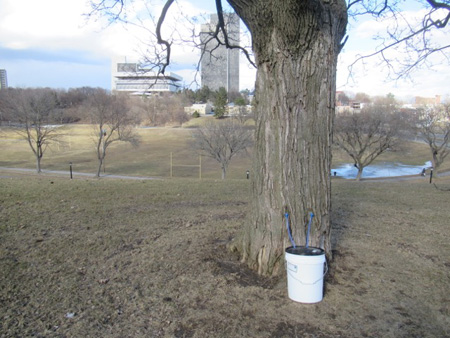March 26, 2019
And a visit to the farm to find out how it’s done
The white buckets had been sitting under the maple trees that line Morton Avenue for weeks before they actually registered on my conscious mind. That sudden awakening of my awareness happened on a Saturday afternoon in the middle of March when I was circling the block with my pickup, about to load it with usable stuff from our house that we didn’t want. The plan was to take our stuff to a dropoff point for the Albany Really Really Free Market, which takes place every three months at the Albany Social Justice Center on 33 Central Avenue. But that’s another story in itself.
Anyway, as I slowly drove down Morton, I made a frowny-faced study of the white, five gallon buckets under the trees, and I decided they sure looked to me like maple sap collectors, some 22 by my count from ML King Boulevard to Eagle Street. My first thought was that somebody was stealing sap from our beloved trees brazenly in the open, which is often the best way to get away with stuff like that. But who would do such a thing? Maple sugaring is, after all, some hard work that takes skill. It’s much easier to go buy some at the supermarket.
 Sap Collection Buckets On Morton Avenue
Sap Collection Buckets On Morton Avenue
So after we dropped off our usable crap at what turned out to be a house just outside Albany in Menands, I did an inspection of this sap stealing operation. My main worry was that the trees were being damaged by someone selfish that didn’t care what he or she was doing. To whom, I wondered, could I report this attack on our trees during the weekend? Come Monday morning would the authorities even care? Perhaps I should take this matter into my own hands?
On close inspection I was relieved to see that the sap collection was being done neatly and expertly. Only two little holes had been bored into the base of the trees, and unlike the collection lines at maple sugar farms the two tubes that ran from the trees to the buckets were short and narrow gauge. Clearly whoever did this was not being greedy, taking care as much as possible to not stress the trees any more than necessary.
This was my real concern, stress to the trees. On some maple sugar farms you might notice the trees that get tapped every Spring look kind of narrow and spindly, not happy and expansive. Not always, but often enough. Consider that every single year when the trees wake up and begin to expend energy to grow leaves, some (mostly) hairless monkeys come along and literally suck the vital life blood from their capillaries. Add to this that on Morton Avenue these are urban street trees that are under a great deal of stress already from passing cars, their noise, their air pollution, and vibrations. Is bleeding them a good idea?
 Sticker On The Sides Of The Buckets
Sticker On The Sides Of The Buckets
Turns out I didn’t have to worry about the legitimacy and competence of the sap collectors. It took me a while but I finally noticed the stickers on the side of each bucket that explained this was a project of the Radix Ecological Sustainability Center, the South End’s fabulous urban farm located on Warren Street on the other side of Lincoln Park from my house. I also noted the official seal of the City of Albany on the stickers, which meant that for better or worse the authorities heartily sanctioned this operation.
The fact is, if anybody could do this sort of thing properly then Radix could. Scott Kellogg and Stacy Pettigrew have been managing this innovative urban farm since they started building it in 2009, providing fresh farm goods to the neighbors, along with educational opportunities for students from local grade schools all the way up to graduate schools. The current City administration has recognized Radix as an innovative cultural and economic driver that deserves encouragement. Thus it was no surprise to see the City imprint on the sides of the buckets.
Looking at the Radix page on Spacebook, I noted that they’d had a boiling operation more than a week earlier, on March 7. I’m annoyed with myself for having missed this, so I can’t give any details about how much sap was collected or such. I decided I’d find out if there was going to be another public sap boiling that I could visit, or at the very least what their plans were.
 Kids Testing Finished Maple Syrup At Radix
Kids Testing Finished Maple Syrup At Radix
You see, I had talked to a maple farmer at the Troy Farmer’s Market last weekend, she told me that they had barely started sugaring (collecting sap) because it’s been so cold. The sap flows best during that late winter period when the nights are cold and the temperature gets above freezing during the day. Later in the season when day and night get too warm, the sap still flows but it is too thick and full of, well, nutrients that the trees need to thrive and survive, which we parasitic hairless monkeys consider impurities.
The late season sap is your “grade C dark amber,” which usually gets mixed in with processed food or is choked down by people who pretend it’s tastier than the light amber stuff from earlier in the season. Years ago big food corporations would buy the darkest almost inedible very late season stuff from maple farmers and add a little bit of it to their corn syrup (usually 2%) so they could legally call the glop maple syrup. But due to complaining consumer groups this deceptive legal loophole was changed and the corporations couldn’t make that claim any more, which sadly hit the maple farmers hard for a while. But it also gave the poor a trees a break from very late season bleeding, which is damaging to them.
 Sap Collector In Action
Sap Collector In Action
The maple farmer I hd talked to in Troy told me she was looking forward to the following week because the predictions were that the weather would be just right for sap production, and they were. Of course in Nassau in Rensselaer County where her farm is located, some 15 miles from the South End and about 400 feet higher in elevation, it is significantly cooler there. That farm, by the way, is Wells Maple Farm, from whom we’ve been buying the maple cream that I dutifully spread every morning on The Wife’s english muffins ever since we first found them years ago selling at a county fair. It’s really good stuff.
So I guess I shouldn’t be surprised that Radix has already harvested enough sap to have already had a syrup boiling, it’s a lot warmer in downtown Albany than the outer suburbs. Checking with an authority on maple sugaring I see the following:
In a normal season, a single taphole produces approximately 10- to 12-gallons of sap. Your finished yield of syrup will depend on the sugar content of your sap. Generally, assume a 40-to-1 conversion – so 12 gallons of sap will boil down to 1 quart of syrup.